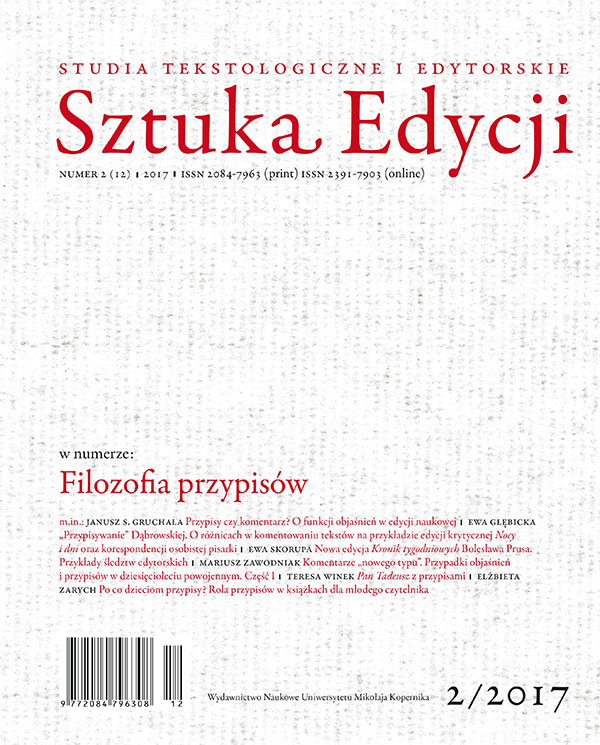“Footnoting” Dąbrowska. On differences in commenting texts on the example of critical edition of Noce i dnie and the writer’s personal correspondence
DOI:
https://doi.org/10.12775/SE.2017.0015Keywords
Maria Dąbrowska, 20th century letters, 20th century editingAbstract
In the case of writer whose compositions, like Maria Dąbrowska’s ones, have a clear biographical background, questions concerning the role of footnotes in particular works is complicated due to their relations with records of personal life, such as diaries and private correspondence. The novels Noce i dnie and Przygody człowieka myślącego are based on the writer’s personal experience, which is confirmed by her diary and letters. An editor comes across bilateral relations between those texts (for example, letters by Marian Dąbrowski used in Noce i dnie as letters by Marcin Śniadowski, in the correspondence with Stanisław Stempowski they both refer to the novel’s plot and language). In the case of the writer’s correspondence with her husband, a political activist and an officer, on the other hand, we are dealing with the necessity of providing a comment of mostly historical nature; the footnotes concern political facts in the macro- and micro-scale, with the latter level being apparently more important. Comparing the letters written by Dąbrowska to Stempowski (from the years 1924–1951) and Anna Kowalska (from the years 1940–1964) with the diaries of both writers gives the possibility to seek for an answer to the question in what dimension the letters and diary entries can be treated as a testimony of personal life, and to what extent we are dealing the strategy of self-creation, addressed also to future readers. Such intention by Dąbrowska is indicated by the fact of making typescript copies of her letters to Stempowski – significantly edited, subjected to self-censorship. The question concerning the role of footnotes thus changes into a textological problem, and the footnotes become a tool for criticism of the text. The correspondence with Anna Kowalska, on the other hand, apart from a panorama of Polish life, sketches an image of complicated and difficult personal relations between the writers, Stempowski, and Jerzy Kowalski, and at the text level – with many parallel confessions in the writers’ diaries, in many cases denying the letters’ content. The role of footnotes here will be to study those differences and general contrasts in accounts. Due to the collection’s size (which forces edition in the selection process) the correspondence is a special editorial challenge, as the footnotes must fill the gaps created as a result of the editor’s decision. Those numerous entanglements of Dąbrowska’s texts into the biographical background prove that the function of footnotes in the edition of her individual texts (including letters) are dependent on the degree of their biographical connections, and make it necessary for an editor to confront them.
References
Dąbrowska M., 2009, Dzienniki 1914–1965, t. 1–13, pod red. T. Drewnowskiego, Warszawa.
Dąbrowska M., Dąbrowski M., 2005, Ich noce i dnie. Korespondencja Marii i Mariana Dąbrowskich 1909–1925, oprac. E. Głębicka, Warszawa.
Dąbrowska M., Stempowski J., 2010, Listy 1926–1965, t. 1–3, oprac., wstępem i przypisami opatrzył A. S. Kowalczyk, Warszawa.
Dąbrowska M., 1935, Listy z podróży, „Wiadomości Literackie”, nr 47.
Dąbrowska M., 2013, Noce i dnie, vol. 1–3, wstęp, oprac. i przypisy E. Głębicka, Warszawa.
Dąbrowski J., 1977, Dziennik 1914–1918, wstęp i aneks J. Zdrada, przygotowanie tekstu i przypisy J. Zdrada przy współudziale E. Dąbrowskiej, Kraków.
Głębicka E., 2017, Marii Dąbrowskiej podróż dookoła Europy w 1935 roku, „Sztuka Edycji. Studia Tekstologiczne i Edytorskie”, nr 1 (11): Podróżopisarstwo a problemy edytorskie, pod red. M. Kowalskiej.
Kowalska A., Dzienniki 1927–1969, Warszawa 2008.
Downloads
Published
How to Cite
Issue
Section
Stats
Number of views and downloads: 547
Number of citations: 0



